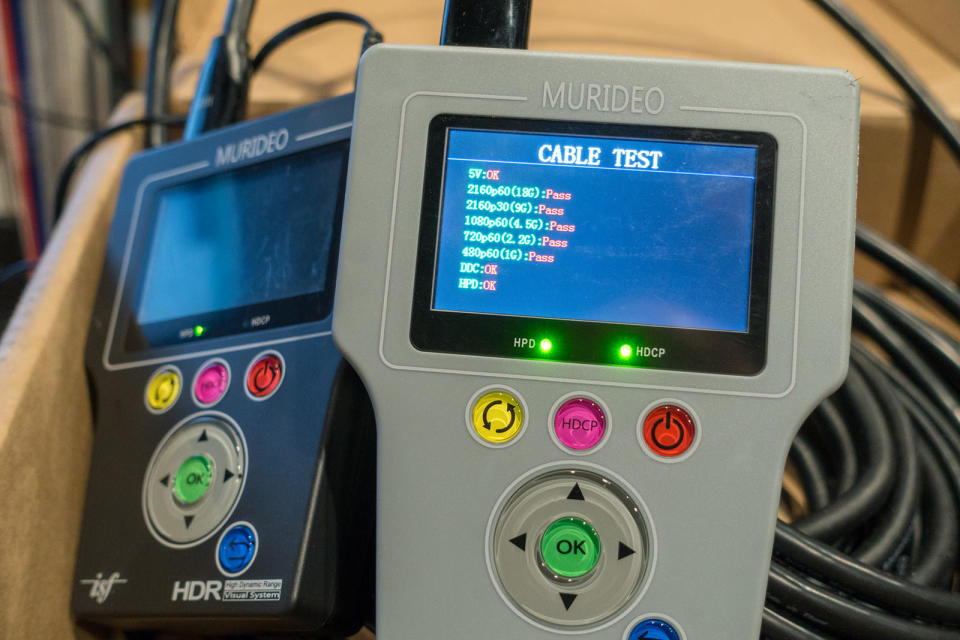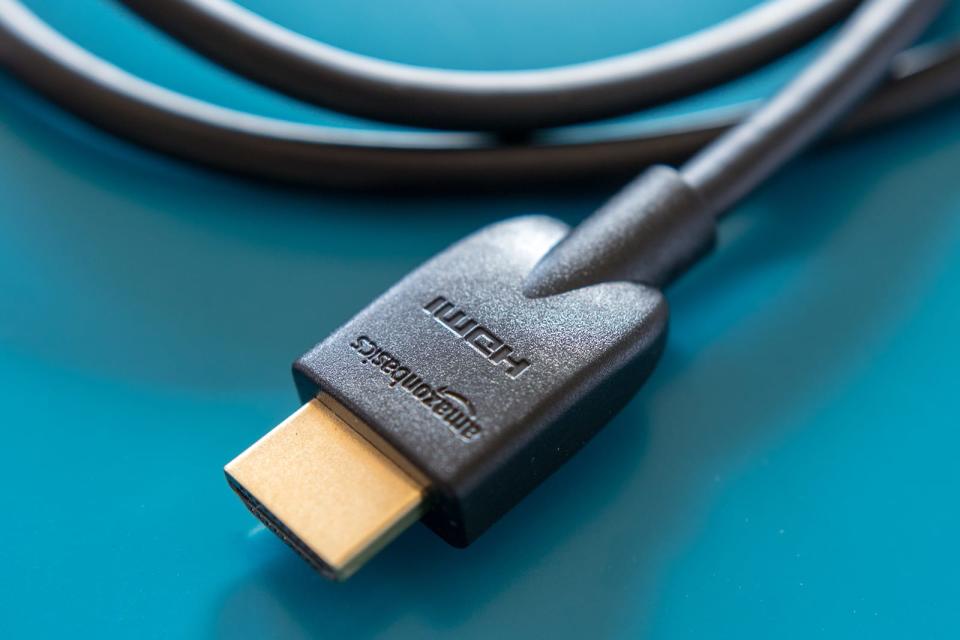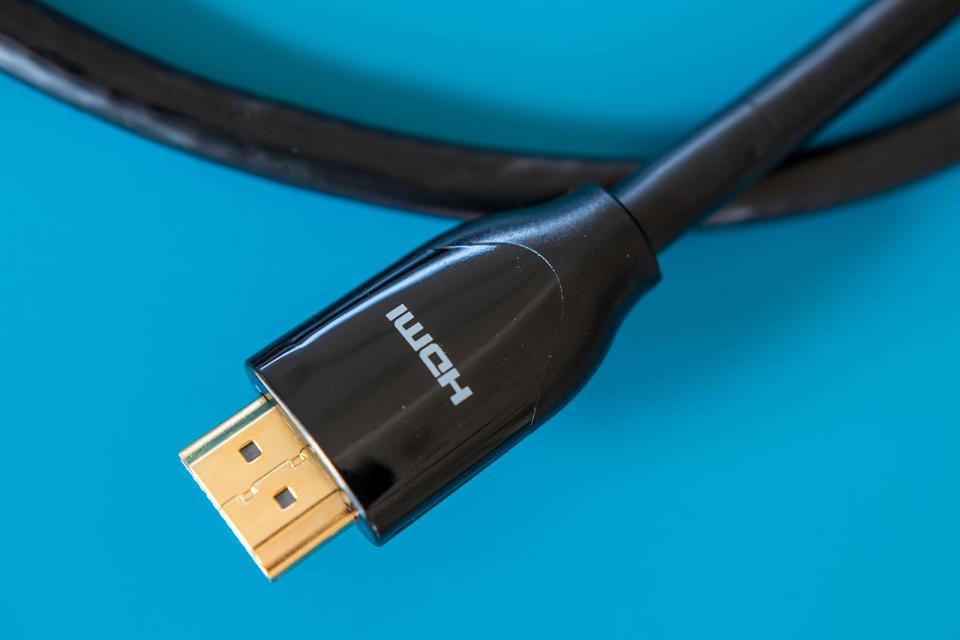Cheap, great HDMI cables
Try AmazonBasics, especially if you're a Prime member.

By Geoffrey Morrison
This post was done in partnership with Wirecutter. When readers choose to buy Wirecutter's independently chosen editorial picks, Wirecutter and Engadget may earn affiliate commission. Read the full guide to cheap, great HDMI cables.
If I needed an HDMI cable, I'd get the 3-foot AmazonBasics High-Speed HDMI Cable. This cable (also available in lengths up to 25 feet) will handle the 18 Gbps (gigabits per second) of data required of Ultra HD 4K video with HDR. It also has a lifetime warranty and free shipping if you're a Prime member. You might be able to find even cheaper HDMI cables, but none have its warranty and easy return policy.
The AmazonBasics High-Speed HDMI Cable is a no-frills HDMI cable, but with HDMI, frills aren't necessary. The cable is sturdily built and works with any video signal of today (and probably ones into the near future). Both the 3- and 15-foot lengths passed all our tests, including HDR tests. It has a 4.6/5 rating on Amazon from over 15,000 reviews. They sell for about $2 per foot or less, if you have Amazon Prime (free shipping). If you don't have Prime, Amazon lowered the price of their free shipping to orders above $35. Or, if you just don't want to go with Amazon, Monoprice cables work the same and are very close in price.
The Monoprice Certified Premium High Speed HDMI Cables work just as well as the AmazonBasics cables but are slightly more expensive when you include shipping. Either way, the prices are very close. Monoprice also has a far greater variety of lengths and thicknesses across a huge number of different series. So if you need a short, skinny cable or very long lengths to make your installation work, Monoprice likely has an inexpensive option that will do the job.
For reasons we'll explain, there is no need to spend more on a basic HDMI cable.
Why you should trust me
In addition to being the editor at large here at Wirecutter, I write for CNET and Forbes. I've also written for Home Theater magazine and was the editor in chief of Home Entertainment magazine. I've been interviewed by a wide range of TV and radio stations, including NBC, NPR, and the BBC.
There is also no one who has researched and written more about HDMI cables. Since 2011, my "Why all HDMI cables are the same" series of articles at CNET have had millions of pageviews (more on this later).
Who's this for
Do your HDMI cables work? If so, great! Keep them. If you haven't changed your gear, there's no performance boost to be had with new HDMI cables.
If you've bought new gear or are planning on buying new gear, you might need new cables. Depending when you bought your cables, and how well made they were, they might work with 4K video, and maybe even HDR. However, the only way to find out is to test them. If you set your source, a Ultra HD Blu-ray player, say, to output 4K HDR, and you don't get an image, you probably need new cables.
Keep in mind that even though new TVs need an HDMI 2.0 connection to work with Ultra HD Blu-ray, there is no such thing as an HDMI 2.0 cable. The chips in the TV and the source need to be HDMI 2.0, but the cable is just a dumb tube. Any High Speed HDMI cable should work fine with 4K as long as it's rated to deliver 18 Gbps.
The longer the cable, or the less well made, the less likely it will work with higher resolutions, even if it worked with 1080p. Though not a perfect analogy, you can think of this as trying to force too much water through a pipe that's too small. A "1080p" amount of water will work fine, but the "2160p" amount of water for 4K won't fit through the pipe and allow the TV to display the image. Still, the pipe (your current cable) may work just fine, so it's worth checking to make sure before you spend the money on a new cable.
Keep in mind, though, if the TV is designed to display HDR (high dynamic range), and you're using an external HDR source like a media streamer (but not the directly-connected Roku Stick+) or Ultra HD Blu-ray player, it's even less likely an older cable will work. 4K HDR is a lot of data (more "water"). Given how inexpensive new cables are that will work, it shouldn't be too disappointed if your old cables need replacing. Still, it might be worth checking if yours work. If you play a 4K HDR video on the source, and your TV says it's a 4K HDR video... success! The cable works. If the TV doesn't show what you're trying to send, flickers, has sparkles/snow, or otherwise looks wonky, you need a new cable.
Soon you'll start seeing TVs with "HDMI 2.1." Despite the nominal numerical change, this is a huge increase in features and capability for the HDMI connection—resolution capacity up to 10K, higher potential frame rates, and more. There are even new cables able to handle 48 Gbps called "Ultra High Speed." Here's the thing: don't worry about it. Very few, if any, TVs will have HDMI 2.1 this year. Fewer still, if any, will take advantage of the headline features. (There won't be any 10K TVs). With the exception of a PC, there are no sources that will output these higher resolutions and framerates. Some TVs may include HDMI 2.1 features, and maybe even say they're HDMI 2.1, but not be the full HDMI 2.1 specification that would require new cables. These could improve the performance of sources like the Xbox One X, but it's unlikely you'll need 48 Gbps cables since the TVs will still be HDMI 2.0.
By the time you need a 48 Gbps cable (if ever), they'll have fallen to the price of the AmazonBasics and Monoprice cables discussed here. Or to put it another way, a $6 cable now plus a $6 cable in 5 years is way better than a $20+ cable now.
But check your current cables. They might work. If they don't, we've got some cheap options for you that will work.
How we picked and tested
It's not possible, due to how they work, for different HDMI cables to have better picture or sound quality. More expensive HDMI cables will not offer any performance advantage over cheap cables. They either work or they don't work.
With that in mind, our criteria was greatly simplified. We looked for cables that worked, are easy to get, come from reputable companies, and offer lifetime warranties. These were the features our last picks had, so for our update it we looked for the latest versions of those cables, and got those in to test.

We brought in 3- and 15-foot cables, testing them on equipment including a Denon AVR-S930H receiver and a JVC DLA-RS440 4K projector with an Oppo UDP-203 as the 4K HDR source. Chris Heinonen, Wirecutter staff writer and editor of Reference Home Theater, then used a Murideo Six-G generator and Six-A analyzer to double-check all the cables could handle the 18 Gbps required for 4K HDR video. (They all could.)
We didn't test any cables longer than 15 feet for this guide, but we have some recommendations based on personal experience in the Monoprice section.
Our pick: AmazonBasics High-Speed HDMI cable

The AmazonBasics High-Speed HDMI Cable is an inexpensive, sturdy, High-Speed HDMI cable that will work with any UHD 4K TV or video source. It's rated up to 18 Gbps, which means it will handle any resolution your current or future TV needs, including Ultra HD 4K and HDR.
It's 3 feet long, which should be sufficient to connect most gear to a receiver, TV, or soundbar, and earned 4.6 (out of 5) stars based on nearly 15,000 reviews. If that's not long enough, it also comes in 6-, 10-, 15-, and 25-foot lengths. We tested both the 3- and 15-foot lengths, and they passed both real-world gear tests and those created by a signal generator and analyser.
Though AmazonBasics cables are available in even longer lengths, those almost certainly won't work for 4K HDR. If you need longer cables, check out the Monoprice section below.
Most important, the AmazonBasics cable has a lifetime warranty. So in the unlikely event it fails, you can get a replacement.
The cables are a bit thick and hard to bend, and given how tiny the myriad wires are inside the cable are, it's best not to crimp it if you don't have to. If your setup needs a bendier wire, check out the Ultra Slim option in the Monoprice section.
Also great: Monoprice Certified Premium High Speed HDMI Cable

The Monoprice Certified Premium High Speed HDMI Cable performs just as well as the AmazonBasics cable, but is a little more expensive when you include shipping. It too is rated (and as we tested, passes) the 18 Gbps required for 4K HDR. If you need very long or short cables to make your setup work, they come in more lengths and thicknesses than Amazon's cables, and they also come with a lifetime warranty.
The Certified Premium cables are available in lengths from 3 to 25 feet and the "Certified Premium" means they're guaranteed to work with 4K HDR video. Or as HDMI Licensing describes it, "The [Certified Premium] program is designed to give consumers peace-of-mind when purchasing new HDMI cables for their 4K/UltraHD products that may include features such as 4K/60, BT.2020 and HDR." This doesn't mean that they work better than the Amazon cables, just that they've gone through an additional testing stage so they can be marketed as Certified Premium and are therefore implied to work. We tested them, anyway, and they passed.
The Essentials Certified Premium cables come with free shipping for the same price as the AmazonBasics cables. They're only available in 3-, 6-, and 10-foot lengths.
The Monoprice Certified Premium, like the Amazon cables, are a bit thick and don't bend easily either. Depending on your setup, a thinner, easier-to-bend cable might be preferable. In that case, the Ultra Slim Certified Premium High Speed HDMI Cable is available in 1- to 8-foot lengths. They're a bit more expensive, so they're not one of our main picks, but they're a lot thinner and easier to manage in tight spaces.
We didn't test really long cables for this guide, but Monoprice makes several series built to handle long distances. I have 40- and 50-foot DynamicView Active High Speed HDMI cables in my lab. They handle 4K just fine, and I have no reason to think they wouldn't do HDR as Monoprice claims. They also sell HDMI-to-optical cables that run over 300 feet that Monoprice claims can handle 18 Gbps, but such extreme lengths are beyond what we were looking for.
If you want to skip long wires altogether, check out our guide to The Best Wireless HDMI Video Transmitter.
Running in-wall cables
Before you run HDMI (or any wires) through your walls:
Check local building codes!
Check the wire!
Make sure you thoroughly check your cable with your gear before you run it through your walls. This may sound obvious, but you'd be shocked (and saddened) by how many emails I get from people who didn't do this.
Also check your local building codes in case you need to run conduit. The Certified Premium High Speed HDMI Cable is CL-3 rated, meaning they can go in many walls. There's also Monoprice's CL-2 rated Commercial Series, but these are rated for 10.2 Gbps, not 18, so they can handle 4K/24, but not 4K HDR. Since this isn't a category we get many questions about, we didn't dive further. But if you find some cables that are CL rated and can handle 18 Gbps, they should work; just test them with your gear before you run them through your walls.
The competition
There are countless HDMI cables available that range in price from "a lot" to "are you kidding me?"
Going through each brand and cable isn't necessary, as there are only two claims these cables make to justify their prices, and both are easily refuted.
1. Better picture and/or sound quality: As we discussed earlier, this isn't possible. The only way one cable could make your content look or sound better is if it changed the data flowing across them. Not only is that impossible, if any of the data going across somehow got changed, the only two possible results at the TV end would be sparkles (a pixel dropping out, quite noticeable) or the entire image dropping out. It can't look sharper (or softer), brighter (or dimmer), more colorful (or muted). This would mean huge aspects of the image have changed, and HDMI cables just don't work like that. It would be like saying a better Ethernet cable changes what your emails say. Same idea.
Over longer runs, the signal can degrade, but that doesn't mean the image degrades. There is no linear correlation between signal quality and picture quality. This isn't analog. That isn't how HDMI cables work. The image will look perfect, regardless of the signal strength, up to the point where dropouts or sparkles happen. After that, there's nothing. Before that is perfect.
There are people all over the Internet who claim to have seen huge improvements after switching to expensive HDMI cables. Objectively, this isn't possible. There are any number of possibilities regarding what's going on (different settings, confirmation bias, HDMI cable company employees...).
2. Better made: The other common boast is that more expensive HDMI cables are better made, implying they'll last longer. Whether this is true is actually pretty irrelevant. Both Amazon and Monoprice have a lifetime warranty on its cables. So even if one breaks, you can get a new one.
Even if that weren't true, and let's say for some reason the $6 HDMI cable you buy lasts only two years (it will likely last longer) and you need to replace it. You've spent $12. How is a $100 HDMI cable that lasts four years a better deal?
Additional science and testing
My many HDMI articles are linked throughout this guide. Each one was heavily researched, including interviews and discussions with the companies that make the HDMI send/receive chips, and with HDMI Licensing, which is in charge of the actual HDMI specification.
I've also done hands-on testing, both for this guide and when necessary, the other articles as well. If you want additional objective testing, here are a few great sources worth reading.
Audioholics did a massive article a few years ago testing long HDMI cables. Some advice there is a touch dated, but the core of the science is still sound. "I have to come away saying that most cables under 4-5 meters will pass just about anything in today's arsenal of 1080p." Or if you prefer a shorter, more succinct version, look to the more recent The Truth vs Hype about Expensive HDMI Cables: "So, does a $10 HDMI cable make your system look or sound different from a $100 or $1,000 cable? The short answer is, 'Absolutely not.'"
Expertreviews.co.uk's Expensive HDMI cables make no difference—the absolute proof is a great article with some awesomely extensive objective testing: "After methodically testing each cable, our comprehensive results revealed the truth. We couldn't find a single error in any of the frames of video we captured using our tests, regardless of the cable we used. Even allowing for a single error per billion bits, none of our captured frames contained as much as a single pixel out of order by a single colour shade."
Here's Tested's The Difference Between Cheap and Expensive HDMI Cables: "As should be abundantly clear, expensive HDMI cables are simply not worth purchasing for normal use. In the case that you are running cable in a permanent fashion through walls or ceilings, it may be prudent to spend a little extra for heavier-duty cables for the sake of longevity, but if you're spending extra on gold-plated connectors and the like, you are doing little more than embedding hard-earned cash in the walls of your home."
Eurogamer did a similar test, comparing the actual output frames, "[T]he conclusion is that you can run any HDMI cable—no matter how cheap—and get identical results." And also, "[T]he important thing to point out is that there is no real parallel with the world of analogue cables."
Here's a reference in Popular Mechanics in Brand-Name HDMI Cables: Are They Worth It?: "The fact is, HDMI is digital, meaning you either get the feed or you don't. High prices and gimmicks like gold-plating don't affect 1s and 0s. Our advice: Purchase your wiring online for cheap, and use the saved money to upgrade to a larger flat screen."
And although this is another one of mine, it shows all the hands-on testing I did leading up to the first CNET article. "The fact is, below 50 feet, performance is going to be a LOT more uniform. In other words, you'll have more cables that will work on everything. As such, it's even more likely that a cheap cable will perform the same as their more expensive counterparts. At short distances (under 10 feet), like we've always said, there's not going to be any difference."
This guide may have been updated by Wirecutter. To see the current recommendation, please go here.
When readers choose to buy Wirecutter's independently chosen editorial picks, Wirecutter and Engadget may earn affiliate commissions.
